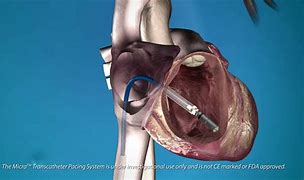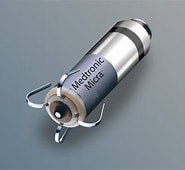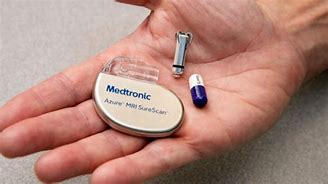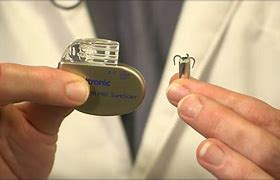
The World’s Smallest Pacemaker is Approved by the FDA!
Your Quality of Life May Depend on it
How The Micra, World’s Smallest Pacemaker Works, the First Time!
Your doctor will insert a straw-like catheter system into a vein, typically near the upper thigh area of your leg. The catheter system moves the Micra into the right ventricle of the heart.


New State of the Art Pacemaker
The Micra is the world’s smallest pacemaker and is approved by the FDA.
It is now being used at Stoney Brook University Heart Institute to treat some patients with a heart rhythm disorder called Bradycardia, also called slow heart rate.
The heart beats too slow for the heart to pump enough oxygen-rich blood to meet the body’s needs. When this happens, a person may feel weak or out of breath, have no energy or sometimes faint with even minor exertion.
Heartbeats are caused by electrical pulsing within the cardiac muscle.
If the heart’s internal electrical system isn’t keeping the heart rate at a normal pace, a pacemaker may be implanted.
When the heart’s rhythm isn’t right, the pacemaker sends an electric impulse to the heart to help normalize the rhythm and ease a patient’s symptoms.
To implant a traditional pacemaker
A “pocket” is made under the skin just below the collarbone. Wires are then guided through a shoulder vein into one, two or three of the heart’s four chambers, depending on a patient’s particular rhythm disorder.
Once the wires are positioned in the heart, they’re attached to the pacemaker. The pacemaker is then inserted into the skin “pocket” and the incision is closed.
Micra Pacemaker is the Newest Invention on the Market
Streamlined implantation method to improve quality of Life
Micra is placed against the heart wall and secured with flexible tines. Your doctor tests the Micra to ensure it is working properly. The catheter system is then removed.
Micra is 93% smaller than the traditional pacemakers, about 1 inch long and on quarter of an inch wide. It can be implanted entirely into the right ventricle of the heart. Patients cannot feel it when it’s in position, unlike traditional pacemakers.
The Micra pacemaker is totally self-contained
Micra Lasts as Long as a Traditional Pacemaker
There are no wires that can break, wear out or malfunction. Everything the Micra needs to regulate the heart is inside the device.
Using fluoroscopic guidance to show real-time moving images of the heart chamber, the pacemaker is attached to the right ventricle muscle in a location where it will provide the best pacing assistance to the patient.
The catheter is then removed and the small incision in the groin is stitched closed, Micra lasts as long as a traditional pacemaker or even longer.
Implantation via catheter
No Incision in the Chest
That means there’s no incision in the chest that could leave a scar or get infected, there’s no “bump” on the chest where a traditional pacemaker sits, and there are no wires connecting the pacemaker to the heart. Patients spend the night after the procedure in the hospital.
If you are interested in having this procedure done, I highly recommend that you talk to your doctor first. Here is a link of people telling their stories about Micra. (Always Discuss Your Options with Your Doctor Beforehand). If you’d like more information about the Micra Pacemaker, please go to Mayo clinic.org
Atrial Fibrillation is an epidemic, Do Your Research Before Deciding
Don’t Just Rely on Your Doctors Opinion
Getting a pacemaker is a lifechanging decision, once you get the procedure done, you cannot reverse it without consequences. They can remove it easily enough, it’s the fact that your heart was weak prior to the pacemaker implant and you’ll go back to the previous symptoms you were having.
Always Check Your Options and Get Second Opinions
If you’re in the stage of needing an ablation, check your options as well. There’s a procedure by the name of The Wolf Minimaze. Dr.Wolf helped design the smaller tool needed to perform this procedure. He’s saved over 2,000 lives performing the Wolf Minimaze ablation procedure.
The last thing you want to do is continue having ablation procedures because they didn’t work the 1st, 2nd or 3rd time. Dr. Wolf’s Minimaze ablation stops Atrial Fibrillation for good! Find him at: Houston Methodist
Doctor Wolf Video-Specializes in Atrial Fibrillation
Houston Methodist Leading Medicine
- Minimally invasive treatment of atrial fibrillation
- Closure of the left atrial appendage to prevent stroke.
- Monitoring of atrial afibrillation
- Inappropriate sinus tachycardia
- Minimall invasive cardiac surgery
- Lung volume reduction surgery
Another Great Resource for You
Here’s another lead from a person that had A-Fib and wouldn’t stop researching ablation until he found one of the best surgeons. He actually found him in France and flew there to have the ablation done that cured him of A-Fib. He wrote books about his experience and started a website, https://a-fib.com/.
A perfect example of why people, such as Steve Ryan have said, “Do not blindly follow your doctor’s advice, always educate yourself“. Do not to jump into getting a pacemaker unless you have no other choice left. He had Catheter Ablations until I believe the 3rd time was the charm and he’s been A-Fib free since 2019.

Steve Ryan said the treatment since his first ablation in 1998 had advanced by light years including a 3D mapping and ablation system and catheter technologies by 2019.
This brings us to why I’m talking about Steve. Well, I didn’t have a choice, the heart gets tired after years of irregular beating and finally gives out. That is why I have a pacemaker. But it’s the same one that they make an incision above your heart by the shoulder.
I got my pacemaker in 2017 and now technology is out with an even better pacemaker that’s less invasive and overall, less to no complications and 93% smaller than the conventional ones. This newest Micra pacemaker is such a huge relief to many I’m sure, and I’m really glad technology is moving fast on saving people from heart disease and offering a better quality of life.
It’s a miracle to me, maybe by the time mine runs out of battery life, (in about 13 years) I’ll get it replaced with the Micra pacemaker!
Thanks for stopping in, this is my first Blog on my website. I’ll leave you with Steve Ryans website, it’s good reading… www.A-Fib.com
Thanks, and I wish you all the Best, if you’d like to leave a comment below, Feel Free
